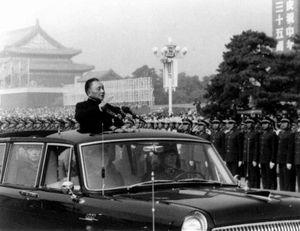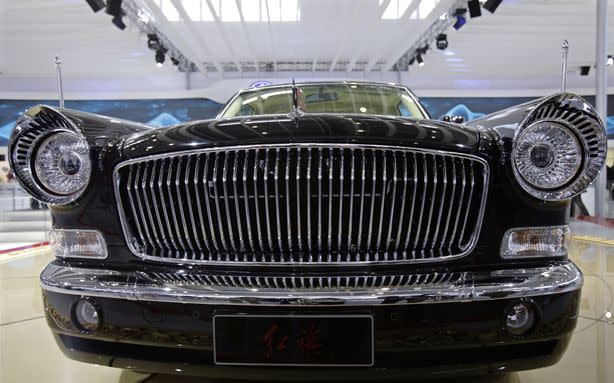Why China's 'Red Flag' Limo Is More Than Just a Car
Elite Chinese government officials have grown accustomed to the luxuries of riding around in Beamers and Benzes. Whether those officials like it or not, China is swapping its beloved German vehicles of choice for a new fleet of bug-eyed, boxy Hongqi sedans, the domestic luxury cars once known as "Red Flag" limousines—a move that's more about image than anything else. And in China, image is everything.
RELATED: Violence in China, Barbra Streisand, and the Nationals
The Hongqi is on the comeback, the Associated Press explains, with new limos going into production this past spring. Car News China, a China-based site focusing on the country's automotive industry, says that the L5 version of the limo debuted in April. The cars largely disappeared in the 1980s, but "now Beijing is reviving the brand to its former glory as a rolling chrome-and-steel embodiment of national pride and ambition," the AP reports.
RELATED: Five Best Tuesday Columns
What do national pride and ambition have to do with four wheels and a ton of steel? Well, just take a look at what's been happening in Detroit. Ever since the bailout of GM and Chrysler, President Obama has equated national pride with a robust homegrown auto industry. These days, words like "powerhouse" are being thrown around to describe the invigorated U.S. auto industry, in what is supposed to be taken as a sign of our overall economic resurgence.
RELATED: Bill Clinton, Joe Frazier, and Joaquin Phoenix
That's why rehabbing the Hongqi is an important public gesture for China, signaling a move away from foreign brands. According to the AP, foreign-made vehicles currently account for 70 percent of the country's new car purchases, and make up 80 percent of the vehicles purchased by officials and government agencies.
RELATED: China Creates Its Own, Norwegian-Free Peace Prize
And the red-flag limo is a crucial symbol of Chinese might, the AP reports:
The giant homegrown sedans were once among the most distinctive icons of the People's Republic. Chairman Mao Zedong perched in the back of one to inspect Red Guards in the 1960s. President Richard Nixon rode through Beijing in one during his breakthrough 1972 visit. Bob Hope rode in one too, and was mysteriously told that the trunk was off-limits.
China's officials' taste for BMW and Mercedes Benz cars are well known—in 2009, there was an uproar when those two brands were added to the list of "official" government vehicles, according to the Global Times.
RELATED: How Xi Jinping, China's Presumed Successor, Would Govern
"I think it would be odd to promote the China Dream with senior officials riding around in foreign limousines, so it seems to me to be a natural extension of (Xi's) desire to boost respect and prestige for the made-in-China brand of the revolution," a China expert at Harvard told the AP. "If Hongqi is able to succeed with officials, this may also have a positive impact for the private car market," another added.
The move is also seen as a way for China to reinforce a message about the strength of its culture. "China wants to make clear to foreign visitors that it will not become just another Western society with Western goods and taste," Jonathan Holslag, research fellow at the Institute for Contemporary China Studies at the University of Brussels, told the AP. That's part of the reason why recent high profile visitors like French President François Hollande and South Korea's Park Geun-hye were both driven around in Hongqis.
The more modest versions of the Hongqi fleet for about $50,000 and the top of line L9 model, complete with an armored chassis, is reportedly sold for $800,000.



